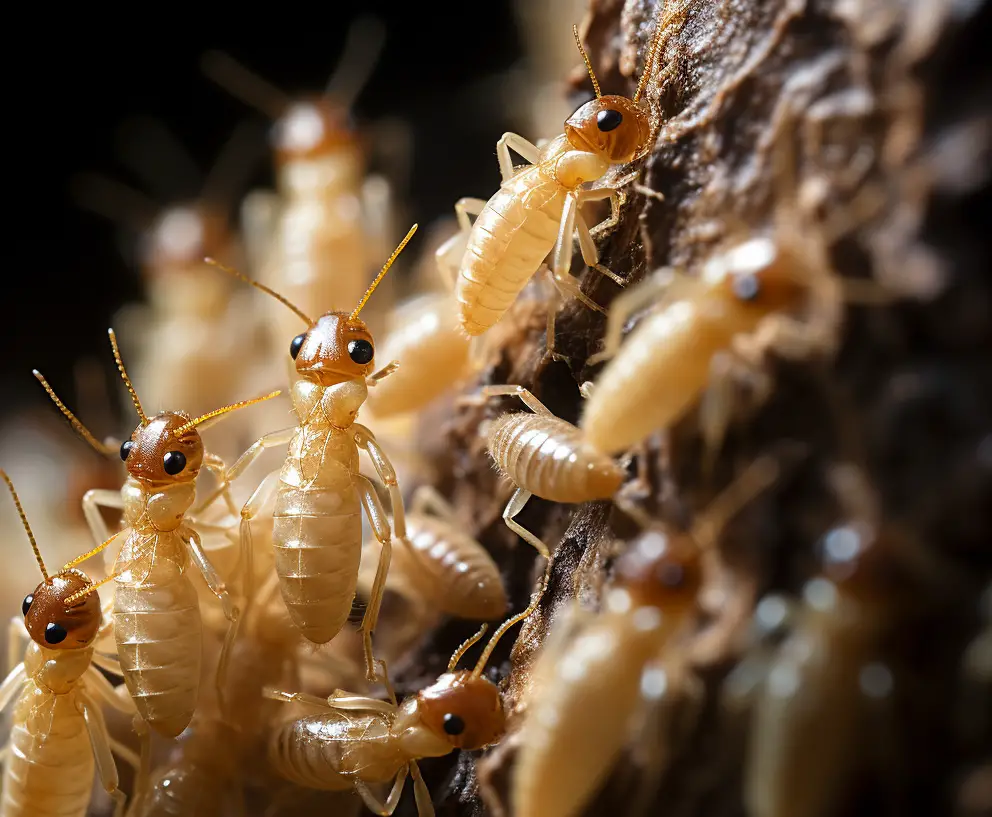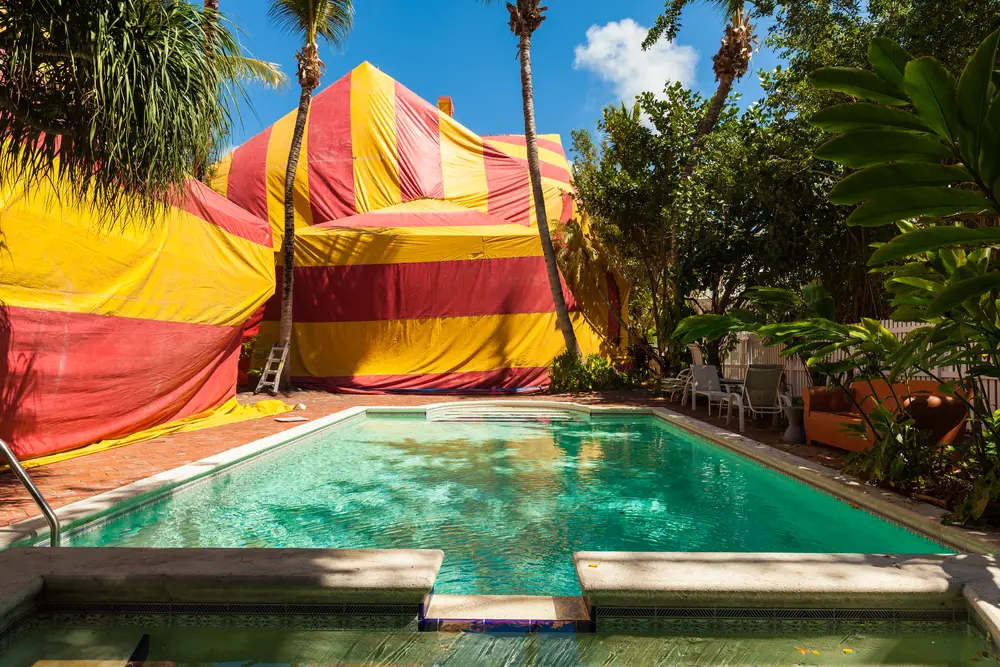Termites are well known for their destructive behavior, causing significant damage to wooden structures and crops.
Understanding the times when termites are most active can help homeowners and property managers take appropriate measures to prevent infestations and minimize damage.
Quick Answer:
Termites are most active in spring and summer, especially during swarming season. In warmer climates or heated buildings, they can be active all year. While they might not always be visible, they can cause damage continuously, even in colder months.
In addition to seasonal fluctuations, daily patterns of termite activity can also be observed.
Termites are more likely to be active during daylight hours, although they may continue foraging or working on their nests at night.
Understanding Termite Activity
Termite Lifecycles
Termites are social insects that live in colonies, consisting of three primary types or castes: reproductive, worker, and soldier termites. A termite’s life begins as a small egg, which develops into a nymph.
Over time, the nymphs will go through multiple molts to become adults, eventually turning into one of the three caste types.
- Reproductive termites, also known as alates or swarmers, are responsible for creating new colonies. They are flying insects that leave their existing colonies to mate and establish a new colony.
- Worker termites make up the majority of the colony population. Their primary responsibility is to gather and provide food for the colony, maintain the nest, and take care of the young termites.
- Soldier termites are responsible for defending the colony against threats, such as ants or other predators. They have larger heads with strong mandibles for battling intruders.
Behavior of Termites
Most termite species are active year-round, but their activity levels tend to increase during the swarming season. This is also when reproductive termites, also known as swarmers, emerge from their colonies to mate and form new colonies.
The swarming season typically occurs during the warmer months, usually beginning in the spring and lasting until the early fall. However, the exact timing of swarming may vary depending on the species and their specific environmental factors.
During the swarming season, reproductive termites will leave their nests in large groups consisting of male and female swarmers. Once they find a suitable mating location, they will shed their wings and pair off to start a new colony.
Most Active Period for Termites
Temperature and Termites
Termites are ectothermic insects, which means they rely on environmental temperatures to regulate their body temperature. Their activity levels are, therefore, influenced by the weather and temperature.
Termites prefer warmer conditions, and their most active period generally occurs when temperatures range between 70°F and 90°F. In colder temperatures, termites tend to become sluggish and less active.
During extreme heat or cold, termites are forced to retreat into their nests to maintain a stable internal temperature. This behavior is more pronounced in the winter months when some species cease their activities altogether and go into a dormant state until the spring arrives with warmer temperatures.
Seasonal Activity of Termites
- Summer: During the hot summer season, termite activity is at its peak as they take advantage of the warm temperatures to forage and expand their colonies. However, during the hottest parts of the day, they may retreat to their nests to avoid extreme heat.
- Fall: In fall, termite activity starts to decrease gradually. As temperatures drop, termites become less active and focus on preparing for the winter season by storing food to sustain the colony.
- Winter: The cold winter season is typically not termites’ most active period. In regions with harsh winters, termites might enter a dormant state, reducing their activity significantly. However, in warmer areas, the drop in activity may be less noticeable.
- Spring: The mild temperatures of spring encourage termites to exit their dormant state and resume foraging. This season often sees a surge in termite activity, with increased sightings of swarms outside the colonies.
Termites are generally more active during the day when temperatures are suitable for their foraging and reproductive activities. However, some species, like subterranean termites, do remain active during the night, as well.
As their activity is largely temperature-driven, the morning and late afternoon may be the peak periods when they venture out of their nests.
Termite Species and Their Activity

Subterranean Termites
Subterranean termites are the most common and destructive termite species. They form large, decentralized colonies underground, which allows them to easily access buildings and homes.
These termites are most active during the warmer months when the weather conditions optimize their reproduction and foraging rates. Eastern subterranean termites, for example, are especially prevalent in the eastern regions of the United States.
Their activity is typically dictated by:
- Soil temperature
- Moisture levels
- Availability of food sources
Drywood Termites
Drywood termites differ from subterranean termites as they do not create large colonies underground. Instead, they infest wood directly, creating smaller colonies within their chosen food source.
These termites are most active during warmer temperatures and are typically found in the southern and coastal regions of the United States.
Factors affecting their activity include:
- Wood moisture content
- Ambient temperature
- Availability of suitable wood sources
Formosan Termites
Formosan termites are a particularly aggressive species of subterranean termites, known for their devastating capabilities and large colony size, with some colonies comprising millions of individuals.
These termites prefer warmer climates and are prone to be highly active during warmer temperatures. They are typically found in the southeastern parts of the United States and Hawaii.
Their activity is influenced by:
- Humidity levels
- Temperature
- Availability of cellulose-rich materials
Signs of Termite Infestation

Visible Signs
One of the first indications of a termite infestation is the presence of droppings. Termites produce small, pellet-like droppings, typically near the areas where they are feeding. Another sign to look for is discarded wings.
This is an indication of a termite swarm, where reproductive termites have left their colonies to mate and establish new ones. Keep an eye out for mud tubes, which are tunnels built by termites for protection and to maintain moisture levels.
These tubes are often found around the foundation and walls of a building.
Structural Damage
Termite damage can gradually weaken the structure of a building. One indication of this is the appearance of cracks in walls, floors, and ceilings. These cracks may develop as a result of termite infestations, as they chew away at the wood and other structural materials.
Look for areas of wood that sound hollow when tapped, which may indicate that termites have caused damage beneath the surface. Regular inspections are crucial to detect termite damage early and ensure that any issues are addressed promptly.
Termite Habitat and Survival
Termites are social insects that thrive in dark, moist environments. They are most active in warmer seasons and during the day. To survive, termites require suitable nesting sites, access to moisture, and a steady food source.
Termite Underground Nests
Subterranean termites build their nests underground, often close to a food source like wood or decaying plant material. These nests are composed of a series of interconnected galleries and chambers that serve various purposes, such as egg-laying, food storage, and waste management.
Termites also construct mud tubes leading from their nests to their food sources, providing them with shelter and protection from predators. It is important to note that subterranean termites can also infest treated wood, making it essential for homeowners to monitor their property for signs of termite activity.
Termite Soil Option
Termites rely on soil to retain moisture and maintain optimal living conditions within their nests. Soil serves as a barrier against predators and helps retain heat, keeping the nest at a comfortable temperature.
Additionally, soil contains cellulose, a primary component of termites’ diet. Thus, the choice of soil type can greatly impact termite survival.
Different soil types offer various benefits to termites:
- Clay soil: Provides greater stability for nest structure and retains moisture well.
- Sandy soil: Easier to excavate and construct mud tubes.
- Loam soil: Combines the benefits of clay and sandy soils, offering both stability and ease of excavation.
In summary, termites thrive in habitats that provide suitable nesting sites, access to moisture, and a steady supply of food sources such as wood and cellulose. Understanding their nesting habits and soil preferences can help in the early detection and prevention of termite infestations.
Termite Management and Control
Prevention Measures
To prevent termites from infesting your home, it is essential to take appropriate measures. These include:
- Regularly inspecting your home for signs of termites, such as mud tubes, swarmers, and damaged wood.
- Eliminating sources of moisture by fixing leaky pipes, gutters, or downspouts and ensuring proper ventilation in crawl spaces.
- Removing wood-to-ground contact by keeping firewood, lumber, and other wooden objects away from your home’s foundation. Also, use concrete or metal supports to elevate wooden structures like sheds or decks.
- Sealing entry points by closing up any cracks or gaps in the foundation, walls, or windows where termites could enter.
- Using termite-resistant materials when constructing or renovating your home, such as pressure-treated wood or metal.
Professional Treatment Options

While homeowners can implement prevention measures, professional termite treatment is highly recommended for comprehensive management and control. Some common professional treatment options include:
- Liquid termite treatments: This involves applying a liquid termiticide to the soil around your home, creating a barrier to keep termites from entering. Some liquid treatments may also be applied directly to wood surfaces to protect against termite infestation.
- Baiting systems: Bait stations are placed around your property, containing a slow-acting poison that termites will consume and share with their colony, eventually eliminating the entire colony.
- Fumigation: This method is typically used for extensive infestations, where a tent is placed over the home, and a gas is released to eliminate termite populations within the structure.
Regardless of the treatment method chosen, it’s crucial to work with a licensed pest control professional, such as Orkin, to ensure effective termite control. They will conduct thorough inspections, make treatment recommendations, and implement a customized termite management plan tailored to your home.
Other Factors Affecting Termite Activity
Moisture and Termite Activity
Termites thrive in environments with high moisture levels, as it is essential for their survival. Moisture problems in and around a home can significantly increase termite activity. Leaks, poor drainage, and improperly maintained gutters can contribute to excessive moisture, making the area more attractive to termites.
Additionally, wood debris, such as sawdust and fallen trees, can retain moisture and provide an ideal habitat for termites to forage and establish colonies.
To reduce termite activity, it is essential to address moisture problems by fixing leaks, ensuring proper drainage, and cleaning gutters regularly. Additionally, maintaining proper ventilation through functional vents can help control moisture levels inside the home.
Construction and Termites
The type of construction and foundation of a building can also impact termite activity. Concrete foundations, for example, are less susceptible to termite infestations than wooden ones.
However, even concrete foundations can develop cracks over time, allowing termites access to the structure.
When constructing a new building or making renovations, it is crucial to incorporate termite-resistant materials and techniques to minimize the chances of an infestation.
For example, using pressure-treated wood or metal fasteners instead of nails can reduce the likelihood of termite damage. Furthermore, incorporating proper drainage systems and ensuring the foundation is well-sealed can help protect against termite activity.


